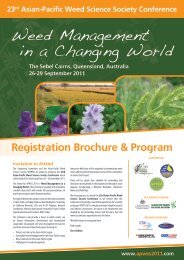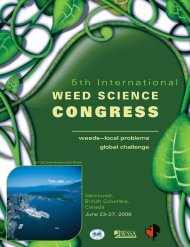PARAQUAT
PARAQUAT
PARAQUAT
Create successful ePaper yourself
Turn your PDF publications into a flip-book with our unique Google optimized e-Paper software.
Hoek & Konradsen 2005). Yet a study in<br />
Korea in 2007, of 250 attempted suicides with<br />
paraquat, revealed that only 38% of people had<br />
intentionally selected paraquat as the agent,<br />
indicating that if paraquat was not available<br />
the survival rate from attempted suicide would<br />
be significantly higher (Seok et al 2009). This<br />
is very important, given that in countries such<br />
as Sri Lanka intentional self-poisoning is “often<br />
a result of impulsive behaviour rather than the<br />
result of long-standing psychiatric problems”.<br />
Sudden anger and grief are common triggers<br />
(van der Hoek et al 1998). A Sri Lankan study<br />
found that 85% of self-poisoning patients cited<br />
easy availability as their basis for choice of<br />
poison; more than 50% ingested the poison<br />
less than 30 minutes after deciding to self-harm<br />
(Eddleston et al 2006). Experience has shown<br />
that restrictions on availability of paraquat (e.g.<br />
in Samoa) and other highly toxic pesticides have<br />
reduced deaths from poisoning (Roberts et al<br />
2003; Gunnell et al 2007) – see also Figure 1.<br />
Most intentional self-poisoning occurs<br />
via ingestion, although injection with fatal<br />
consequences has been reported in Korea (Kim<br />
et al 2000; Choi et al 2008) and Taiwan (Hsu et<br />
al 2003; Chen et al 2009).<br />
Numerous cases of intentional paraquat selfpoisoning<br />
have been reported in Malaysia,<br />
South Korea, Taiwan, Thailand, and Sri Lanka.<br />
It is reported to be less common in India – 6%<br />
of 84 poisoning cases admitted to a Respiratory<br />
Intensive Care Unit in North India between<br />
1998 and 2006 involved paraquat (Agarwal et<br />
al 2006). In 1993 Fiji and Japan were reported<br />
to be countries with high rates of paraquat<br />
poisoning, with the rate in Fiji being 47 deaths<br />
per million people per year, and in Japan 11<br />
deaths/million/year, compared with the USA rate<br />
of 0.004/million/year (Tinoco et al 1993).<br />
Sri Lanka<br />
Thirty-two cases of paraquat poisoning,<br />
including 10 deaths, were recorded in just 2<br />
rural hospitals in Sri Lanka in a 1-year period<br />
in 1998-99 (van der Hoek & Konradsen 2005).<br />
Over a 2-year period, 2004-5, 774 paraquat<br />
patients were registered with 9 rural hospitals.<br />
Syngenta ran a study on these to compare<br />
the outcome of the poisoning with their new<br />
formulation Gramoxone INTEON, touted as a<br />
partial solution to the suicide problem. Although<br />
the rate of survival with the new formulation was<br />
35.6% compared with 25.5% for the original<br />
formulation, still 186 people died after ingesting<br />
INTEON (Wilks et al 2008). Between 6 and 7<br />
out of every ten people who ingested the new<br />
formulation still died (Bateman 2008). A second<br />
study of 533 paraquat poisonings in 10 hospitals<br />
in Sri Lanka, from October 2006 to August<br />
2008, failed to show any benefi cial effect of the<br />
INTEON formulation (Wilks et al 2010).<br />
South Korea<br />
In South Korea, where paraquat has been<br />
used for 3 decades, it is estimated to cause<br />
2,000 poisonings annually, with a 40-50%<br />
mortality rate. An investigation of 154 cases<br />
with 34% fatality in 1999, found that 73.3% were<br />
intentional ingestion (Hwang et al 2002). The<br />
total number of pesticide poisoning deaths from<br />
1996 through 2005 was 25,360. 84.8% of these<br />
were from intentional self-poisoning. Paraquat<br />
was the most frequent cause, accounting for<br />
538 (35.5%) of all pesticide-related deaths (Lee<br />
& Cha 2009). In 1999, the Korean Agricultural<br />
Promotion Agency estimated that there were<br />
800 deaths due to paraquat poisoning annually<br />
in Korea. In 2005, that number had fallen to 256<br />
cases in 9 months (Yoon 2009).<br />
Thailand<br />
Paraquat was responsible for 23.7% (376 cases<br />
including 150 deaths) of all poisoning cases in<br />
Thailand between the years 2001 and 2004. This<br />
includes intentional and unintentional, adult and<br />
child fi gures for pesticide poisoning in Thailand,<br />
although the majority of all poisoning cases<br />
were adult intentional (89.9%) (Wananukul et al<br />
2007).<br />
Japan<br />
From 1998 to 2002, paraquat was responsible<br />
for 20% of the 345 cases of pesticide poisoning<br />
seen at hospitals affi liated with the Japanese<br />
Association of Rural Medicine, with a mortality<br />
rate of 70%. Suicide accounted for 70% of all<br />
pesticide poisoning cases (Nagami et al 2005).<br />
In 1990 Eisler reported that, in Japan, more than<br />
1,000 persons each year are reportedly poisoned<br />
by paraquat, but didn’t identify what proportion<br />
of these were occupational poisonings.<br />
Malaysia<br />
During the period 1986-96, paraquat was<br />
25




